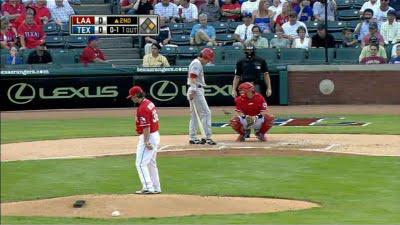
Besides looking in the dugout for signs from his coach, the catcher
will watch the batter's feet and eyes before giving the sign.
He watches the batter's feet. As the batter positions his feet in the batter's box, the catcher usually will glance downward to watch where his feet are being set. Occasionally a batter will tip off what he's thinking or what he's going to do by positioning his feet a little differently. For example, if a batter normally sets up in the back of the box but now has his feet up in the box a little closer to the pitcher, it could mean the batter is thinking of bunting or could mean he's preparing to hit a curve ball before it has more time to break. Of course, there could be other interpretations but the point is, the hitter did something different with his feet. A catcher needs to notice this because it may provide a clue as to what the batter's thoughts or intentions are.
He watches the batter's eyes. After watching the batter enter the box and before giving the sign to the pitcher, you'll probably see the catcher glance up towards the batter's eyes. In doing so, he's checking to see if the batter is attempting to steal the signs and/or steal the location of the pitch. Because of all the cameras facing the hitter during a major league game, big league teams tend to know, or at least suspect, which batters try to get the signs or the location of the pitch. Some batters will literally turn their head back a little so they can peek at the catcher's signs. Other batters might take a pretend half swing and look down towards the bat or plate while doing so. While looking down at the plate or bat, these hitters may hope to get a peek at the sign or at least see which side of the plate the catcher is setting up on. Because of all this, it is to the catcher's advantage to give the sign to the pitcher when the batter's eyes are looking at the pitcher and not down at the plate or back towards the catcher. This requires the catcher to see where the batter's eyes are facing. It also helps if the catcher does not set up too early in terms of his location. At the major league level, catchers tend to move to the location very late, often not until the pitcher is just about to release the ball. The timing of this prevents the hitter from seeing it as well as from having a teammate or coach relay the info to the batter. All this tends to not be as necessary at the lower levels but it's all an attempt to keep the pitch and it's location a secret from the batter.

